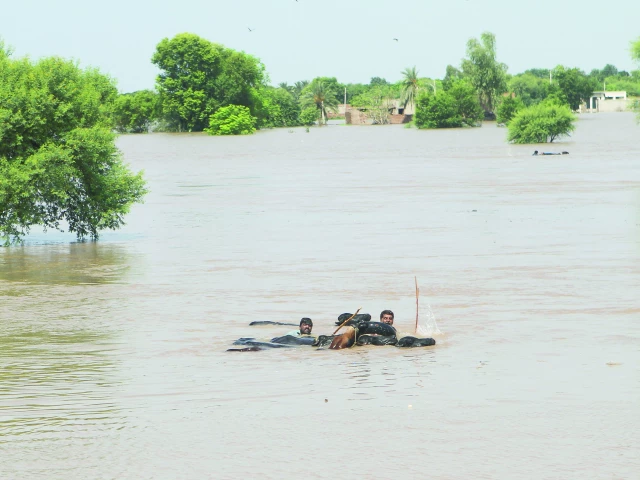Lahore:
Floodwaters continued to beat the country’s heart country on Thursday and pushed the death toll to 884 and received urgent warnings of further destruction in Punjab and Sindh.
Authorities said that to save Multan from being flooded, they are considering violating Chenab Riverbank. It will allow water to be released on the outskirts of the city so that the levels of the river can come down.
Heavy rain in the Himalayas continued to tilt Pakistan on Thursday with the flooding of homes and highways that worsen as large rivers flooded.
Met Office has warned that rain is expected to continue until September 9.
A tough monsoon season has brought tremendous destruction in the region this year and killed 880 in Pakistan during the season. Torrential rain has raised many rivers that encourage authorities in India to release water from dams and further flood areas on both sides of the border.
The countries share rivers flowing from India to Pakistan. New Delhi has issued seven warnings to Islamabad about the opening of dam gates, three in the last 24 hours, officials in Pakistan said.
Irfan Ali Kathia, Director General of Punjab Disaster Management Authority, Reuters said on Thursday that three rivers in Pakistan have been affected by the release of more water from Indian dams.
India opened waste roads at the Baglihar and Salal Dams of Chenab and cited heavy rain in the upstream upland.
Through diplomatic channels, New Delhi also warned Islamabad about releases from Harike and Ferozepur Main Works on Sutlej. Pakistan’s Ministry of Water Resources issued a flood alarm in response.
Provincial Disaster Management Authority (PDMA) in Punjab has released details of the water level at Indian dams. It has warned that the water level of these reservoirs is increasing.
According to PDMA General Director, the situation is monitored around the clock.
At Pong Dam in the Indian state of Himachal Pradesh, the water level at the Beas River has reached 1,394.51 feet. Inflow at the dam is recorded at 132,595 CUSSCS, while the outflow is 100,000 CUSSCS.
At Bhakra Dam built on the Sutlej River also in Himachal Pradesh, the water level has risen to 1,679 feet and is approaching maximum capacity. Inflow is 95,400 CUSSCS, while the outflow is 73,459 CUSSCS.
At Harike Headworks – at the confluence of the rivers Sutlej and Beas – 347,500 CUSSCS, with outflow recorded at 330,677 CUSSCS. PDMA stated that both inflow and outflow are steadily rising.
In Punjab, 1.8 million people have been evacuated in recent weeks after flooding water immersed nearly 3,900 villages.
National Disaster Management Authority (NDMA) said in its latest Bulletin that a mortality rate was reported in Swabi, Khyber-Pakhtunkhwa, while four people were injured in Lahore and Sheikhupura over the past 24 hours.
Since June 26, Punjab has registered 223 deaths and 653 injuries, while Khyber-Pakhtunkhwa remains the worst affected province with 489 deaths and 359 injuries. Sindh has reported 58 deaths, Gilgit-Baltistan 41, Azad Jammu and Kashmir 38, Balochistan 26 and Islamabad nine.
The floods have damaged more than 9,200 houses nationwide, including 4,700 in Khyber Pakhtunkhwa and over 2,100 in Azad Kashmir. Nearly 6,200 livestock has been lost. At least 239 bridges and 671 kilometers of roads have also been washed away or severely damaged.
Over the past 24 hours alone, 31 more houses were damaged over Punjab, Khyber Pakhtunkhwa, Gilgit-Baltistan and Azad Kashmir.
Rescue operations remain intense. Over the past 24 hours, 989 operations in Punjab alone saved nearly one million people, while 61 operations in Sindh evacuated 28,940. Nationwide, more than 2.1 million people have been rescued since the floods began.
Auxiliary supplies – including tents, ration packages, mattresses, mosquito nets, tarpaulins and life jackets – are distributed by federal and provincial agencies with support from humanitarian partners.
Punjab rivers violation of dams
At Ganda Singh Wala in Kasur, a flood wave of more than 319,000 CUSERCs immersed over 100 villages and nearly 18,000 hectares of agricultural land. In Lodhran and Vehari, violations in protective dams left entire settlements underwater.
Ravi and Chenab also caused destruction. Floodwaters went into houses in Kabirwala after the collapse of the provisional lives, while Ravi in Multan reached the Ravi Railway Bridge. In Shujaabad, dozens of villages were submerged, and violations in channels near Sidhnai and Rango left thousands of displaced.
Gujrat City also endured a separate disaster after 577 millimeters of precipitation in 24 hours triggered serious urban areas, immersed streets, government offices and shops under up to four meters of water. Mosques issued repeated messages that encouraged residents to move to safer soil.
Auxiliary Commissioner Nabeel Javed said that more than 3.8 million people have been affected over Punjab, with 1.8 million already evacuated. At least 46 deaths in Punjab have been linked to the flood.
The provincial disaster management authority (PDMA) said that about 4,000 villages have been immersed, 1.5 million residents rescued, and more than a million livestock moved.
Agriculture has been destroyed. More than 1.3 million hectares of crops are destroyed with Faisalabad, Gujranwala and the Gujrat divisions hardest hit. Officials warned that the damage could have lasting consequences for Punjab’s agricultural economy.
Flood control officials confirmed extremely high water level at Ganda Singh Wala on Sutlej, Khanewal and Qadirabad at Chenab and Sidhnai at Ravi. PDMA -Human Director Irfan Ali Kathia said the next 24 hours are critical to Multan, where the convergence of Ravi and Chenab threatens nearby districts.



